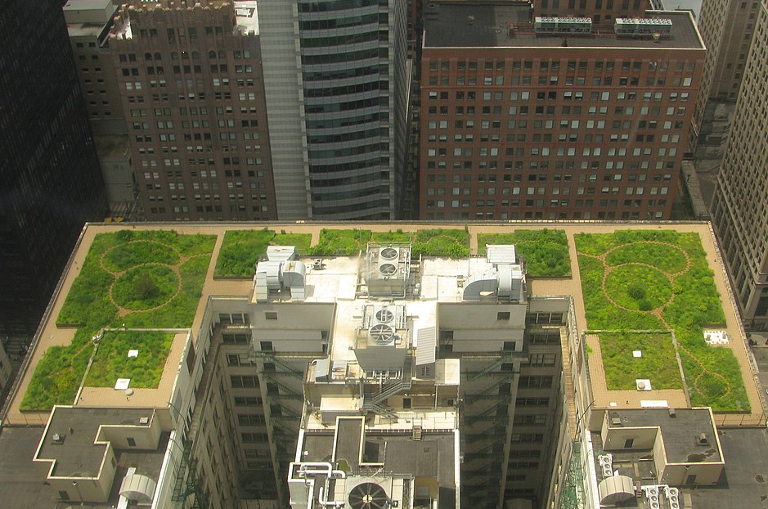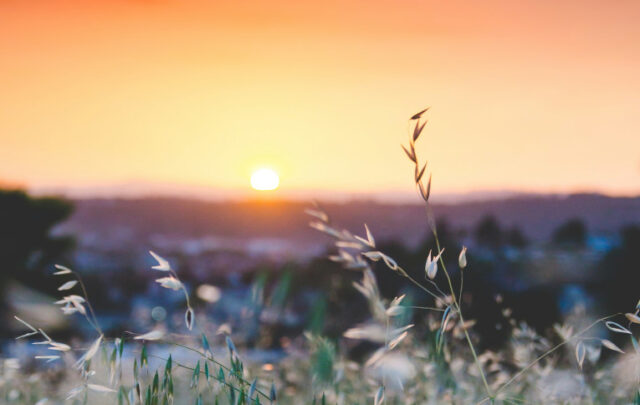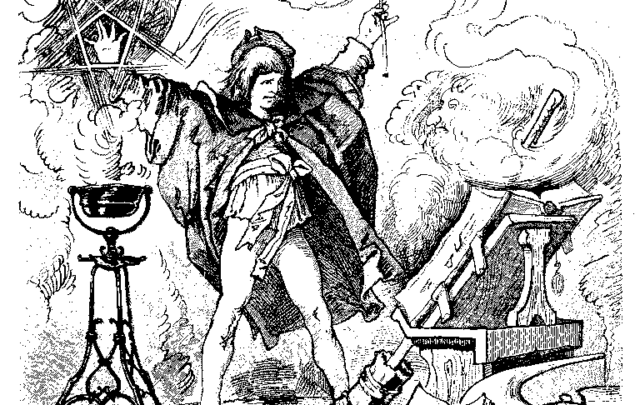 From From the Ground Up by Alison Sant. Copyright © 2022 Alison Sant. Reproduced by permission of Island Press, Washington, D.C.
From From the Ground Up by Alison Sant. Copyright © 2022 Alison Sant. Reproduced by permission of Island Press, Washington, D.C.
Reimagining our cities
For more than three decades, US cities have experimented with ways to remake themselves in response to climate change. From tactical interventions and urban prototypes to pilot projects, streets have been reconfigured to accommodate people, bikes, and transit. Roads, parks, and backyards have been made absorbent. Forest canopies have been broadened and urban waters restored. These efforts have been motivated by necessity as the impacts of the changing climate are not only projected into the future, but are being experienced today. However, the set of opportunities to remake cities as more vibrant, equitable, humane, and joyous places is also aspirational. Today, the bar is being lifted to make cities places in which people don’t just survive the future, but thrive in it.
As the United States grows in its capacity to respond to climate change, the path to progress will go through US cities. The year 2007 was the first time in human history that the majority of the world’s population lived in urban places. By 2018 in the United States, 83 percent of the population lived in just 3 percent of the country’s total land area. This density makes cities one of the most significant opportunities for addressing human’s impact on climate change. Together, the world’s cities are responsible for 75 percent of global carbon emissions. The United States faces unique challenges in addressing the climate crisis. It is the second-largest emitter in the world after China, a country with a population four times larger. Transportation alone accounts for the largest share of emissions in the United States. The dense footprints of many US cities support low- and zero-carbon mobility options, including transit, biking, and walking. Expanding these modes is essential to mitigating climate change and holds the promise of building more equitable transportation systems, creating more equally distributed opportunities, and increasing economic mobility.
From the Ground Up: Local Efforts to Create Resilient Cities focuses on the unique ways in which US cities are expanding the scope of global solutions that mitigate and adapt to climate change while creating equitable and livable communities in the process. The best examples of this work bring together the energy of community activists, the organization of advocacy groups, the power of city government, and the reach of federal environmental policy. At its strongest, the structure of American democracy—stacked with local, state, and federal structures of governance—provides a context for local innovation that doesn’t exist in the same way as places with centralized authority. However, when administrations leave much undone, more is taken up by the American people.
As a result, this country has a long history of grassroots activism and local invention. Americans are used to rolling up their sleeves and digging in. When ignited by funding and government leadership, and supported by science and policy, the United States provides fertile ground for local solutions to grow quickly.
This book details the pathbreaking work that is remaking US cities, providing evidence that the best of American ingenuity holds the promise for more livable, equitable, and resilient communities in the century to come. The twelve chapters in this book focus on projects in nine places throughout the nation. They profile the questions, provocations, and insights of more than ninety activists, practitioners, academics, government officials, scientists, and advocates who are working in their communities to make a difference.
Part 1 starts at street level, describing how the land allocated to cars is being reclaimed for people. The narrative cuts through the concrete in part 2, describing how streets, yards, roofs, and parks are being made porous to function within watersheds. Part 3 focuses on how US cities are being reforested to mitigate air pollution and heat while making neighborhoods lush. The book ends along the US shorelines in part 4, examining how large-scale ecological restoration is helping buffer future storms in vulnerable communities while returning life to our urban waters. It also looks at the processes by which communities are migrating to higher ground.
Three essays provide national context. Tamika Butler, a national expert on the built environment and equity, writes about the experience of systemic racism and public space. A civil service perspective is offered by Mami Hara, who discusses her work in Seattle Public Utilities and the Philadelphia Water Department. And Professor Kristina Hill, who studies urban hydrology’s relationship to design and social justice, focuses on the ways in which nature-based solutions in watersheds and along shorelines will help populations adapt to sea-level rise and severe storms.
This book is a call to react creatively to the challenges we face. Tested experiments can be built upon and scaled to keep pace with the urgency of climate change. As witnessed during the COVID-19 pandemic, change can happen overnight. Humans’ future resiliency will be measured not just by the infrastructure put in place to manage stormwater or make transit accessible, but by how well we have supported the social infrastructure that allows our communities to respond to the challenges that lie ahead. Much of the work profiled in this book charts a path to confronting racial inequities, focusing on climate mitigation and adaptation as a context for creating opportunities for all communities while making neighborhood-led solutions the centerpiece of change.
Tragically, the comfort of the private automobile has been prioritized above the quality of life in cities. As Richard Rothstein described in his book The Color of Law: The Forgotten History of How Our Government Segregated America, the US highway system ripped through Black communities to serve mostly White commuters. As described in part 1, the Rondo neighborhood, the center of Saint Paul’s Black community, was demolished in 1956 to construct the I-94 freeway. In the 1960s, highspeed roadways were run through the Tenderloin, a community of color in San Francisco where many residents live well below the poverty line, creating the city’s most dangerous streets. Nationwide, a staggering number of traffic injuries and fatalities occur each day on US roads. As Angie Schmitt documented in Right of Way: Race, Class, and the Silent Epidemic of Pedestrian Deaths in America, more pedestrians died on streets in 2018 than at any point in a generation, disproportionately killing low-income, Black, Brown, elderly, and disabled people, many of whom exclusively rely on walking and public transit.
Living near roads and highways also exposes residents to toxic levels of air pollution. More than 45 percent of Americans live where pollution levels are too often dangerous to breathe. Worse, this burden is not evenly shared. Communities of color are exposed disproportionately more than White communities to air pollution due to decades of residential segregation and have higher rates of asthma, cancer, and premature death as a consequence. The coronavirus pandemic exposed these underlying inequities. Studies found that even a small increase in longterm exposure to air pollution leads to a large increase in the COVID-19 death rate, making communities of color especially vulnerable. As this book describes, the legacy of slavery and systemic racism has created long-term disparities legible in every aspect of the urban landscape, including access to efficient transportation, well-maintained parks, street trees, economic and educational opportunities, and even the community engagement processes that shape neighborhoods and cities.
As extreme weather events become increasingly common, low-income communities and communities of color are often the hardest hit. Increasing economic disparity and substandard public infrastructure make the most vulnerable populations less resilient in the aftermath of storms. As the case studies in Louisiana describe, of the seven ZIP codes that suffered the costliest flood damage from Hurricane Katrina, four were in neighborhoods with a majority of Black residents. Part 3 examines the inverse relationship between communities of color and urban tree canopy coverage in Washington, DC, and Baltimore. These disparities can make it 15 degrees Fahrenheit hotter in these communities. Along the coastlines and in the hearts of the cities, societal inequities are being exacerbated by the changing climate. These injustices have been allowed to persist, normalized in a country that has left systemic racism unchecked.
Acknowledging and addressing racial inequality in US cities is not only a cobenefit to the changes ahead, but a moral imperative. The solutions to health inequities will be furthered by removing cars from roads and decommissioning highways in favor of bikeways and transit. Investing in parks to protect neighborhoods from flooding will provide much-needed green space in places without access to nature. Community-led solutions for streets can make them safer and cooler while managing stormwater and creating jobs. Communities must direct the transformation of their neighborhoods. Public education, civic participation, local expertise, and collaborative planning are critical to generating successful urban solutions. As Ashwat Narayanan, executive director of Our Street MPLS, said,
“I truly believe in the power of cities to be engines for large-scale change. If we look at how movements have progressed across history, many, many, times it’s communities and cities who’ve taken the lead. Cities have been a driving force for social movements.”
Cities remake themselves in pieces. There are opportunities—with every road that is redesigned, sidewalk that is planted, open space that is forested, and shoreline that is restored—to interject a new idea about how people live in urban spaces and who benefits from them. Can city streets prioritize pedestrians, cyclists, and transit riders? Can public spaces be made greener and safer by supporting community-led solutions? Can investments in cities be the impetus for jobs and economic stability in neighborhoods that need them the most? Can public dialogue give agency to the people most impacted by our changing climate? The case studies in this book provide examples of how these questions are being addressed. There are massive changes ahead. Let’s make sure they are the ones we want to live with.
Teaser photo credit: Chicago City Hall green roof. By 20080708_Chicago_City_Hall_Green_Roof.JPG: TonyTheTigerderivative work: TonyTheTiger (talk) – 20080708_Chicago_City_Hall_Green_Roof.JPG, CC BY-SA 3.0, https://commons.wikimedia.org/w/index.php?curid=10999666





